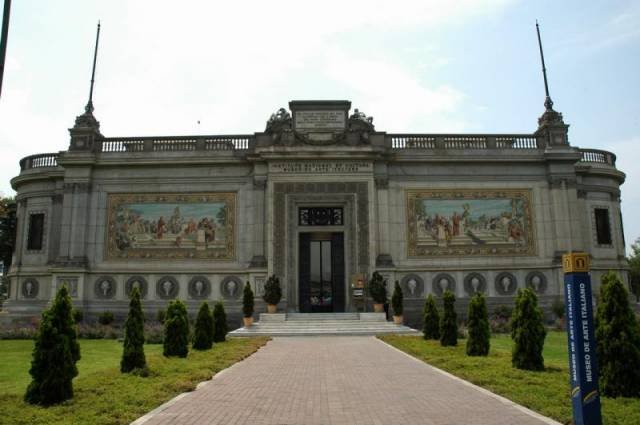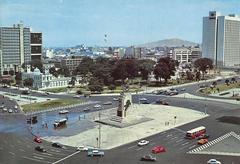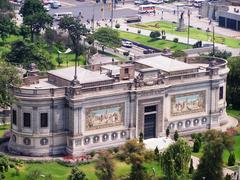
Museum of Italian Art Lima: Visiting Hours, Tickets, and Historical Sites Guide
Date: 14/06/2025
Introduction
The Museum of Italian Art (Museo de Arte Italiano), located in Lima’s historic center, stands as a testament to the enduring cultural ties between Italy and Peru. Established in 1923 as a centennial gift from the Italian community to Peru, the museum is renowned for its neoclassical architecture, exquisite collection, and role as a cultural bridge between the two nations. Housed in a building designed by Italian architect Gaetano Moretti, the museum is both an architectural and artistic landmark, boasting Venetian mosaics, stained glass inspired by Botticelli, and ornamental features reminiscent of Italian Renaissance palaces. Visitors can explore more than 1,200 works—from painting and sculpture to ceramics and decorative arts—making it a must-see destination for anyone interested in Lima’s multicultural heritage (GPSmyCity; Wikipedia; WhichMuseum; Hey Explorer).
Table of Contents
- Introduction
- Origins and Historical Context
- Foundation and Architectural Significance
- Collection Overview and Artistic Legacy
- Cultural and Diplomatic Role
- Visiting Hours, Tickets, and Guided Tours
- Accessibility and Visitor Facilities
- Architectural Features and Design Highlights
- Collection Highlights
- Visitor Experience and Tips
- Nearby Attractions
- Frequently Asked Questions (FAQ)
- Conclusion
- References
Origins and Historical Context
The museum was founded in 1923, commemorating 100 years of Peruvian independence. It was a gesture of friendship from the Italian community and government, reflecting the significant contributions of Italian immigrants to Lima’s culture and urban development in the early 20th century (GPSmyCity). The museum’s establishment marked an important chapter in fostering cross-cultural exchange between Italy and Peru.
Foundation and Architectural Significance
Designed by Milanese architect Gaetano Moretti, the Museum of Italian Art is a striking embodiment of neorenaissance architecture. Its symmetrical façade, adorned with mosaics and reliefs, evokes the grandeur of Italian palaces. The building incorporates classical columns, pilasters, and decorative friezes inspired by masters like Bramante, Donatello, Ghiberti, Michelangelo, and Botticelli (Wikipedia; LimaEasy). Notable exterior features include two large Venetian mosaics depicting luminaries such as Dante Alighieri and Leonardo da Vinci, and emblems of Italian cities, illustrating both the diversity and unity of Italian culture (Tierras Vivas).
Collection Overview and Artistic Legacy
Today, the museum houses Latin America’s most extensive collection of Italian art, with over 1,200 pieces spanning the late 19th and early 20th centuries. The permanent collection includes works by:
- Giovanni Boldini: Celebrated for dynamic, elegant portraiture of the Belle Époque.
- Giorgio de Chirico: Foremost in metaphysical art, known for enigmatic compositions.
- Umberto Boccioni: Futurist pioneer exploring speed, technology, and modernity.
In addition to paintings, the museum boasts significant sculpture, decorative arts, ceramics, Murano glass, and majolica ware. Thematic and chronological organization allows visitors to trace the evolution of Italian art from realism to modernism (WhichMuseum).
Cultural and Diplomatic Role
The museum stands apart as Lima’s only institution exclusively dedicated to Italian art, serving as a hub for cultural diplomacy. It promotes Italian culture through exhibitions, concerts, lectures, and workshops, encouraging dialogue and collaboration between the Italian and Peruvian communities. Its educational programs reach audiences of all ages and backgrounds, strengthening Peru-Italy relations (GPSmyCity).
Visiting Hours, Tickets, and Guided Tours
- Opening Hours:
- Tuesday to Saturday: 10:00 a.m. to 5:00 p.m.
- First Sunday of each month: 10:00 a.m. to 3:00 p.m.
- Closed Mondays and public holidays (Tierras Vivas).
- Tickets:
- General admission is often free; special exhibitions or guided tours may carry a nominal fee.
- Discounts apply for students, seniors, and children; some days may offer free entry (WhichMuseum).
- Guided Tours:
- Available in Spanish and, upon request, English or Italian.
- Tours can be booked in advance and are recommended for in-depth insights.
Accessibility and Visitor Facilities
The museum is wheelchair accessible, with ramps and elevators to all public areas. Special programs for visually impaired visitors include tactile guided tours of sculptures (Wikipedia). Other amenities:
- Cloakroom: Secure storage for personal items.
- Restrooms: Clean and accessible.
- Museum Shop: Art books, souvenirs, and Italian-themed gifts.
- Café: Light refreshments and Italian pastries.
- Library: Books and audiovisual materials about Italian artists.
- Parking and Gardens: Onsite parking and a tranquil outdoor space for visitors (WhichMuseum).
Architectural Features and Design Highlights
- Façade: Adorned with Venetian mosaics and city emblems, celebrating Italian heritage (Tierras Vivas).
- Interior: Six main exhibition rooms, flooded with natural light and crowned with a stained glass window inspired by Botticelli’s “Primavera” (Wikipedia).
- Decorative Details: Reliefs, columns, and ornamental motifs throughout, reflecting Italian Renaissance artistry.
- Preservation: Restoration projects by the National Institute of Culture and Italian embassy ensure integrity of both the building and collection (Wikipedia).
Collection Highlights
Paintings
The museum’s robust painting collection highlights major Italian schools and movements:
- Portraits by Giovanni Boldini: Expressive, elegant depictions of high society.
- Modern works by Giorgio de Chirico and Umberto Boccioni: Showcasing metaphysical and futurist innovations.
- Landscapes and religious scenes: Offering a window into academic and avant-garde trends.
Sculpture
- Ettore Ximenes: Marble busts and allegorical figures.
- Arturo Dazzi: Bronze statuettes and expressive reliefs.
Decorative Arts
- Majolica Ceramics: Vases and plates from Faenza and Deruta, featuring Renaissance motifs.
- Murano Glass: Iconic Venetian glassware.
- Furniture and Textiles: Demonstrating Italy’s interior design traditions.
Temporary Exhibitions
Rotating exhibitions feature contemporary Italian and Peruvian artists, as well as thematic shows that foster cross-cultural understanding.
Visitor Experience and Tips
- Museum Layout: Thematic and chronological displays facilitate an intuitive and enriching visit.
- Signage: Bilingual labels in Spanish and Italian, with some English translations.
- Guided Tours: Enhance appreciation for architecture and collections.
- Photography: Allowed in most galleries without flash; restrictions may apply during temporary shows.
- Best Times to Visit: Weekday mornings or afternoons for a quieter experience.
- Duration: Most visitors spend 1–2 hours; art aficionados may linger longer.
Nearby Attractions
After your museum tour, discover Lima’s other cultural highlights:
- Museum of Art of Lima (MALI): Directly across the street, featuring Peruvian art.
- Parque de la Exposición: Historic park perfect for a stroll.
- Plaza Mayor and San Francisco Monastery: Key historical sites a short ride away.
- Circuito Mágico del Agua: A spectacular water fountain park.
Frequently Asked Questions (FAQ)
Q: What are the Museum of Italian Art’s visiting hours?
A: Tuesday to Saturday, 10:00 a.m. to 5:00 p.m.; first Sunday of each month, 10:00 a.m. to 3:00 p.m.; closed Mondays and public holidays.
Q: How much are tickets?
A: Admission is generally free, but special events or tours may require a small fee. Check the official website for updates.
Q: Is the museum accessible for visitors with disabilities?
A: Yes, with ramps, elevators, and special programs for visually impaired visitors.
Q: Are guided tours available?
A: Yes, in Spanish regularly and in English or Italian upon request.
Q: Can I take photos inside the museum?
A: Non-flash photography is permitted in most galleries.
Q: What nearby attractions can I visit?
A: MALI, Parque de la Exposición, Plaza Mayor, and the San Francisco Monastery are close by.
Conclusion
The Museum of Italian Art in Lima offers an unparalleled cultural experience, merging Italian artistic excellence with Peruvian heritage. Its neoclassical architecture, thoughtfully curated collection, and community engagement make it a cornerstone of Lima’s museum scene. Whether you are drawn by the masterpieces of de Chirico and Boccioni, the grandeur of Venetian mosaics, or the museum’s educational programs, a visit here provides deep insights into the shared history and artistic collaborations between two nations.
For up-to-date information, download the Audiala app, visit the official museum website, and follow us on social media for the latest news, event updates, and exclusive content.
Virtual Tour of the Museum of Italian Art
References
- Museum of Italian Art in Lima: Visiting Hours, Tickets, and Cultural Highlights of a Lima Historical Site, GPSmyCity
- Museo de Arte Italiano official site
- Wikipedia: Museum of Italian Art
- WhichMuseum: Museum of Italian Art Lima
- Hey Explorer: Is Lima Worth Visiting?
- Tierras Vivas: Museum of Italian Art Lima
- LimaEasy: Italian Art Museum
- Salkantay Trekking: Lima Everything You Need to Know
















































































































